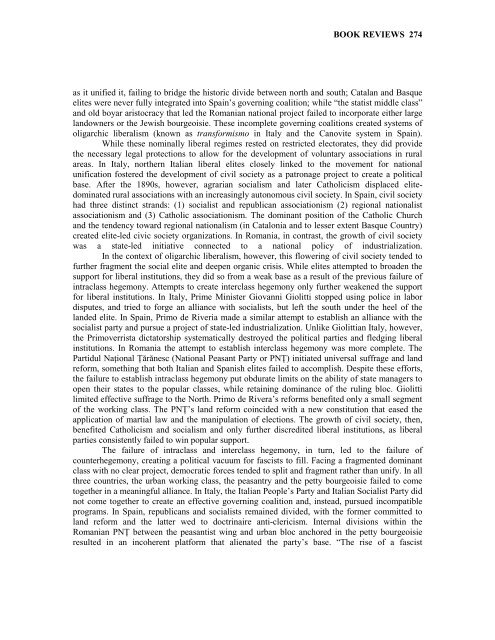Entire Volume 17 issue 1 - Journal of World-Systems Research ...
Entire Volume 17 issue 1 - Journal of World-Systems Research ...
Entire Volume 17 issue 1 - Journal of World-Systems Research ...
Create successful ePaper yourself
Turn your PDF publications into a flip-book with our unique Google optimized e-Paper software.
BOOK REVIEWS 274<br />
as it unified it, failing to bridge the historic divide between north and south; Catalan and Basque<br />
elites were never fully integrated into Spain’s governing coalition; while “the statist middle class”<br />
and old boyar aristocracy that led the Romanian national project failed to incorporate either large<br />
landowners or the Jewish bourgeoisie. These incomplete governing coalitions created systems <strong>of</strong><br />
oligarchic liberalism (known as transformismo in Italy and the Canovite system in Spain).<br />
While these nominally liberal regimes rested on restricted electorates, they did provide<br />
the necessary legal protections to allow for the development <strong>of</strong> voluntary associations in rural<br />
areas. In Italy, northern Italian liberal elites closely linked to the movement for national<br />
unification fostered the development <strong>of</strong> civil society as a patronage project to create a political<br />
base. After the 1890s, however, agrarian socialism and later Catholicism displaced elitedominated<br />
rural associations with an increasingly autonomous civil society. In Spain, civil society<br />
had three distinct strands: (1) socialist and republican associationism (2) regional nationalist<br />
associationism and (3) Catholic associationism. The dominant position <strong>of</strong> the Catholic Church<br />
and the tendency toward regional nationalism (in Catalonia and to lesser extent Basque Country)<br />
created elite-led civic society organizations. In Romania, in contrast, the growth <strong>of</strong> civil society<br />
was a state-led initiative connected to a national policy <strong>of</strong> industrialization.<br />
In the context <strong>of</strong> oligarchic liberalism, however, this flowering <strong>of</strong> civil society tended to<br />
further fragment the social elite and deepen organic crisis. While elites attempted to broaden the<br />
support for liberal institutions, they did so from a weak base as a result <strong>of</strong> the previous failure <strong>of</strong><br />
intraclass hegemony. Attempts to create interclass hegemony only further weakened the support<br />
for liberal institutions. In Italy, Prime Minister Giovanni Giolitti stopped using police in labor<br />
disputes, and tried to forge an alliance with socialists, but left the south under the heel <strong>of</strong> the<br />
landed elite. In Spain, Primo de Riveria made a similar attempt to establish an alliance with the<br />
socialist party and pursue a project <strong>of</strong> state-led industrialization. Unlike Giolittian Italy, however,<br />
the Primoverrista dictatorship systematically destroyed the political parties and fledging liberal<br />
institutions. In Romania the attempt to establish interclass hegemony was more complete. The<br />
Partidul Naţional Ţărănesc (National Peasant Party or PNŢ) initiated universal suffrage and land<br />
reform, something that both Italian and Spanish elites failed to accomplish. Despite these efforts,<br />
the failure to establish intraclass hegemony put obdurate limits on the ability <strong>of</strong> state managers to<br />
open their states to the popular classes, while retaining dominance <strong>of</strong> the ruling bloc. Giolitti<br />
limited effective suffrage to the North. Primo de Rivera’s reforms benefited only a small segment<br />
<strong>of</strong> the working class. The PNŢ’s land reform coincided with a new constitution that eased the<br />
application <strong>of</strong> martial law and the manipulation <strong>of</strong> elections. The growth <strong>of</strong> civil society, then,<br />
benefited Catholicism and socialism and only further discredited liberal institutions, as liberal<br />
parties consistently failed to win popular support.<br />
The failure <strong>of</strong> intraclass and interclass hegemony, in turn, led to the failure <strong>of</strong><br />
counterhegemony, creating a political vacuum for fascists to fill. Facing a fragmented dominant<br />
class with no clear project, democratic forces tended to split and fragment rather than unify. In all<br />
three countries, the urban working class, the peasantry and the petty bourgeoisie failed to come<br />
together in a meaningful alliance. In Italy, the Italian People’s Party and Italian Socialist Party did<br />
not come together to create an effective governing coalition and, instead, pursued incompatible<br />
programs. In Spain, republicans and socialists remained divided, with the former committed to<br />
land reform and the latter wed to doctrinaire anti-clericism. Internal divisions within the<br />
Romanian PNŢ between the peasantist wing and urban bloc anchored in the petty bourgeoisie<br />
resulted in an incoherent platform that alienated the party’s base. “The rise <strong>of</strong> a fascist





